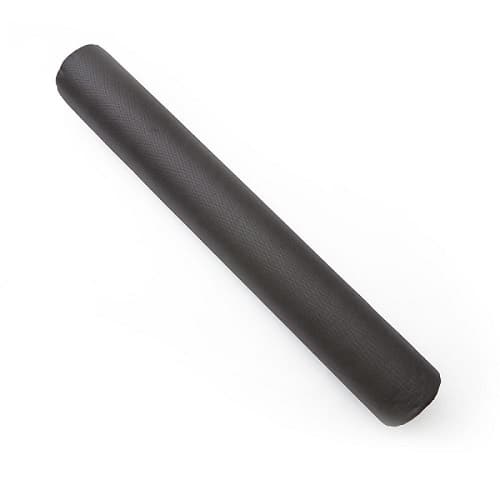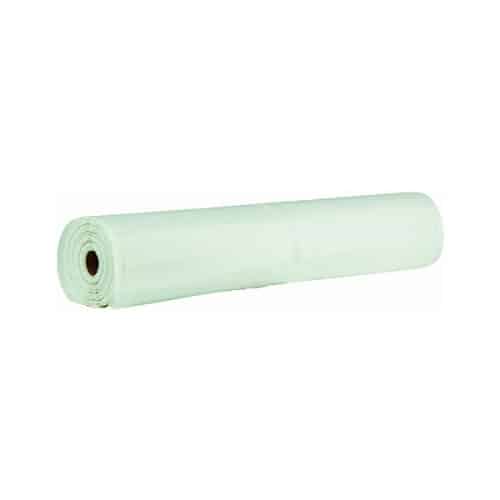The Truth About Landscaping Fabric and 6 Other Easy Ways to Prevent Weeds
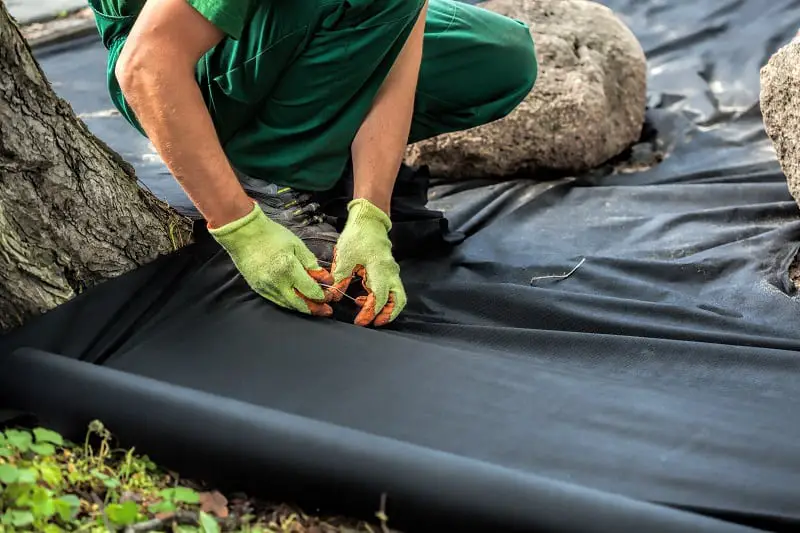
Does laying a physical barrier really prevent weeds?
Quick Navigation
GROWING TIRED OF WATCHING the weeds in your garden grow faster than your veggies? It's a common garden dilemma. And it's common for proactive gardeners (like yourself) to look for a way to put an end to this cycle. Looking for a way to keep the weeds at bay without resorting to spending a lot of time on your knees or working with a hoe. But do any of them actually work?
If you have ever looked at a professional garden installation, you may have noticed they don't have much of a weed problem. One method used to make this happen is the use of landscaping fabric, but there are others such as landscaping plastic, mulch, cardboard and more.
The Jury is Still Out
Okay, so let's start this off by saying the jury is still out on the use of landscaping fabric or plastic sheets.
While many gardeners, both professional and amateur alike swear by these products (yes, they will keep out the weeds), many others say they are not good for your garden and should not be used (they kill off valuable microorganisms and earthworms).
In the end, you have to decide who is right and which of the different weed control methods is going to work best for you.
The 6 Most Common Ways to Prevent Weeds...
1. Landscaping Fabric
Landscaping fabric is a porous material designed specifically to help keep the weed population in your garden under control. It is intended to be placed on top of your garden's soil and then pinned in place and held down by using more soil or mulch.
The fabric is designed to allow water and air to pass through but to ensure no sunlight reaches the soil below it. In doing this, it prevents weeds from being able to germinate and grow. It can be used when planting your garden or added after your plants have come up.
Advantages of Landscaping Fabric
Controls Erosion
Landscaping fabric can be very helpful if your garden suffers from soil erosion problems such as those caused by heavy rains or high winds. It is also very useful if your garden is on a hill to help keep your soil where it belongs.
The fabric will also help to protect your plants' roots from exposure due to erosion that might cause them to succumb to disease, root rot, or many other forms of damage.

Landscaping fabric done properly will prevent weeds in at least the medium and short term
Controls Weeds
We all know that weeds are great at stealing the nutrition your veggies need to flourish from the soil. By keeping the weed population under control, your plants will have a much better chance to grow big and strong, providing you with an exceptionally good harvest.
It is perfect for smaller plants that will in time grow large enough to provide more shade that will also help to keep weeds out of your garden.
Disadvantages of Landscaping Fabric
Adverse Effect on Soil Nutrient Levels
One of the biggest disadvantages of using landscaping fabric is that over time it will have an adverse effect on nutrient levels in your soil. These nutrient levels are dependent on the decomposition of mulch and other materials over time. The fabric will reduce or stop this from happening, leading to "dead" soil that will require significant amendment on a regular basis.
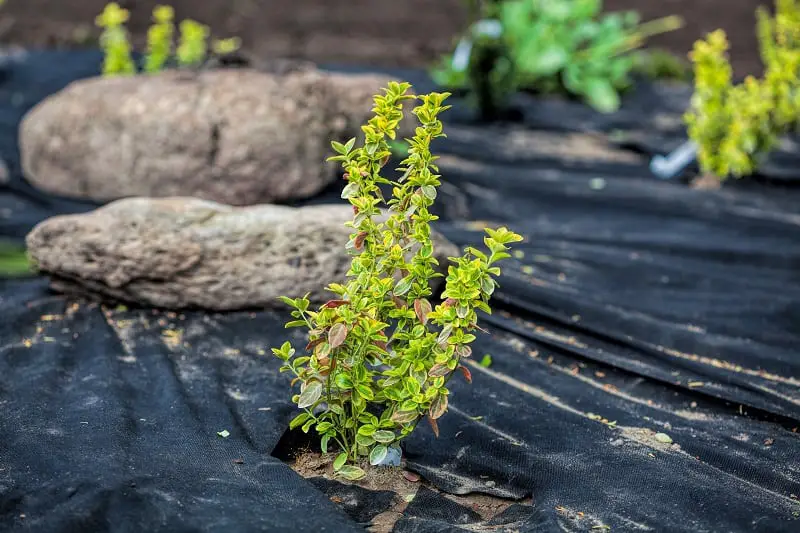
A typical set up of a garden bed covered with landscaping fabric
Loss of Versatility
Many gardeners like to move their plants around or add more as and when needed or wanted. Landscaping fabric was never designed to be versatile and must have holes cut in it every time you want to add more plants. At the same time, if you remove plants, you must patch the fabric or you will soon have weeds growing through the holes.
Scotts 25-Year Pro Landscaping Fabric
Keep weeds at bay without using chemicals
SCOTTS 25-Year Pro Fabric, 3 by 150-Feet
If you are going to use a landscaping fabric to control weeds in your garden, this one by Scotts may be your best choice. It is designed to provide you with up to 25-years' service without breaking down. It also offers excellent erosion control. Thanks to the woven design, water flows through easily, but nothing can grow underneath it.
The fabric is rated at 1.5 ounces and is strong enough to be used under gravel for paths and driveways without suffering any damage. It is easy to work with and comes in a 3-foot wide roll that measures 150-feet long. One thing you should note is that in heavier rains water will pool on the fabric until it has time to drain through.
| Pros | Cons |
| Easy to cut and work with | Some complaints it rips easily |
| Blocks the growth of most weeds | Slow water soak through |
| Has a long lifespan | Grasses may grow through weave |
Landscaping Plastics
Some gardeners find that using landscaping plastic can be a good way to keep weeds under control. As with landscaping fabric, there are a number of advantages and disadvantages to using plastic sheeting in your garden. The most common forms of landscaping plastic are clear and black. Depending on what brand you buy it can vary significantly in thickness and overall quality.
2. Clear Landscaping Plastic
While black sheeting is more commonly used, there are some very distinct advantages to using clear plastic instead. The most obvious advantage to using any kind of plastic sheeting is that it will prevent the growth of weeds. But clear plastic will still let the sunshine reach your soil.
This helps to warm the soil and in many cases will allow you to start planting a little earlier. The heat will also help to kill off any soil borne pathogens. This process is called "solarization" and can help to rid your soil of disease-causing organisms, insects, and of course pathogens.
Covalence Plastics 4-Millimeter Clear Tyco Polyethylene Plastic Sheeting
Listed as a vapor barrier but thick enough to use in the garden
COVELANCE PLASTICSTyco Polyethylene Plastic Sheeting
At 4 millimeters thick, this clear plastic sheeting is more than strong enough to keep the weeds in your garden under control. Each roll is 10 feet wide by 100 feet long, giving you plenty of coverage.
While it is not listed as being for use in landscaping, but it is definitely up to the task. Unlike many other so-called "clear" plastics that end up being milky, this one is crystal clear and will let plenty of sunlight reach the ground under it. It is easy to handle and easy to cut.
One word of caution, however, be sure you are cutting in the right place as repairing erroneous holes can be challenging as most tapes (including duct tape) will not stick to it very well. If you are covering a large area, be prepared to overlap pieces for best results.
| Pros | Cons |
| Rolls are 10 x 50 Feet | Does not allow water to pass through |
| Crystal Clear | Rips easily |
| Easy to work with | Hard to repair rips and tears |
3. Black Landscaping Plastic
Black plastic landscaping fabrics come in many guises, but those that are at least 4 feet wide and at least 1-1.5 millimeters thick are the most commonly used. Bear in mind that if you plan to use the plastic for several years or bury it under mulch, gravel, or a layer of soil, thicker plastic will last longer. Be sure that any sheeting you buy is listed as being UV resistant to help keep it from breaking down.
Black plastic will help hold in any warmth your soil happens to have and may allow a certain amount of heat to build up during the day. However, it will block out the sun's UV rays and in doing so prevents them from killing pathogens, disease-causing microorganisms, and pesky insects. If you live in a colder climate, you may find the heat generated will not even be enough to help kill weeds.
No matter whether you use clear or black landscaping plastic both will not allow water to reach your plants and will also stop any water in your soil from evaporating. This can lead to problems such as root rot that can kill your garden rather than helping it to grow.
Covalence Plastics Black Tyco Polyethylene Plastic Sheeting
Extra-wide rolls make covering larger areas a breeze
COVALENCE PLASTICS Black Tyco Polyethylene Plastic Sheeting
This roll of black sheeting can easily be adapted for use as landscaping plastic and at 12 feet wide is sure to cover a large area of your garden in a hurry. Each roll is 100 feet long each roll provides a lot of coverage. At 6 millimeters, the plastic is thick enough to take significant abuse without falling apart.
Although listed as a construction material, it is perfectly suited to being used out in your garden to help get rid of the weeds. You should be aware, however, that black plastic can trap in excessive amounts of heat that can "cook" your soil and everything in it (including the good bacteria and microorganisms).
| Pros | Cons |
| 12-foot-wide rolls offer plenty of coverage | Can overheat your soil |
| Durable enough to walk on | Rips easily |
| Keeps weeds at bay | Hard to repair rips |
4. Mulch
Mulch is one of the oldest forms of weed prevention short of getting down on your hands and knees so you can pull each weed complete with its roots out of the ground. Depending on the type of mulch you intend to buy, it can be a great way to control the weeds in your garden naturally.
This being said, you can buy mulch made from wood chips or bark, locally at very reasonable prices. This type of mulch will break down over time and help to add nutrients to your garden.
But at the same time as it breaks down, you will need to replace it on a fairly regular basis. You may find that unless you put landscaping fabric or plastic under it, you will still see a small quantity of very brave weeds poking through any holes.
There are a number of rubber mulch alternatives that do not break down or blow away. These have the added advantage of lasting for many years without losing their looks or effectiveness. But, at the same time, you are putting another unnatural layer in your garden.
Scotts® Nature Scapes® Color Enhanced Mulch
Made from natural recovered forest products
SCOTTS Nature Scapes Color Enhanced Mulch
Unlike some "wood" mulch, Scotts never uses wood pallets or old construction debris to make this mulch. It is made from natural recovered forest products that do not contain harmful chemical or nails.
It is available in a range of colors that are guaranteed to stay vibrant all year long. Each bag measure 2 cubic feet for maximum coverage. It should be spread 3 inches thick for maximum weed prevention while still allowing moisture to reach your plants.
| Pros | Cons |
| Color lasts a long time | A bit expensive |
| Made from natural recovered forest materials | Color will come off on your hands when putting down |
| Reduces amount of water needed for your plants | Mixed texture may include twigs and sticks |
5. Cardboard and/or Newspaper
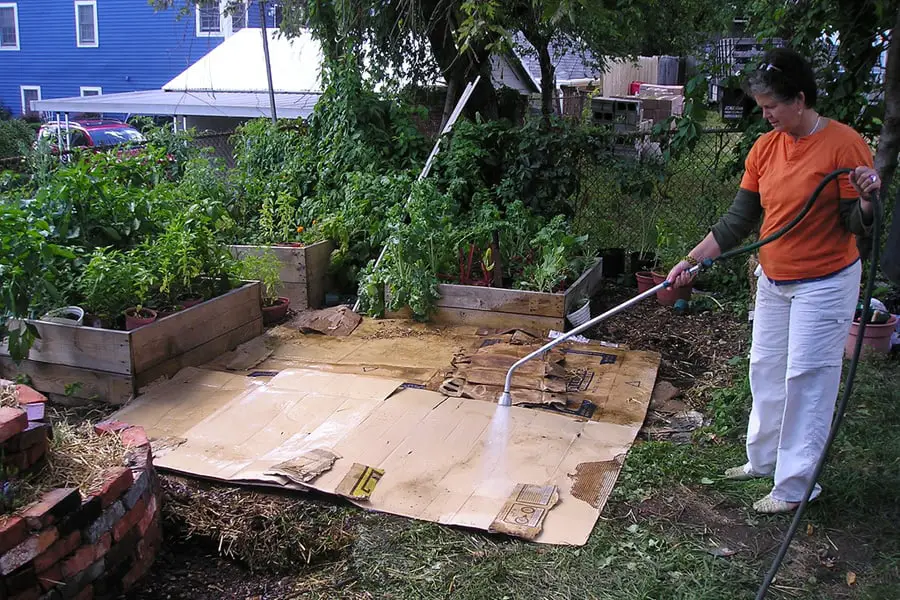
Photo: ‘Cardboard base for raised bed’ CC BY 2.0 JoePhoto
Using cardboard, newspaper or a combination of both has become a popular way to mulch gardens and prevent the growth of weeds at the same time. Along with this, it is a great way to recycle these materials rather than seeing them end up in your local landfill.
Many gardeners will place a layer of cardboard or newspaper in their garden at the beginning of the season and then cover them with mulch. The idea behind this is the same as using landscaping fabrics, plastic sheets, or for that matter mulch by itself.
This idea is to block sunlight from reaching the soil, which in turn will help to prevent the growth of those annoying weeds. Both materials will help to insulate the soil and keep a certain amount of warmth in.
Over time they will also allow water to slowly soak through and add moisture to the soil. Both will eventually decompose and add a number of nutrients back into your soil. The best part is you can find plenty of cardboard at most local businesses and they won't charge you a dime to haul it away.
| Pros | Cons |
| Both decompose adding nutrients | Both are messy |
| Both are free | Newspaper can blow away |
| Both are being recycled | You still need mulch or rocks to hold in place |
6. Chemical Weed Prevention
As with many other facets of our lives, weeds can be controlled through the use of chemicals. Weed preventers and weed killers have become a major factor in both home gardens and industrial farms where growers are more worried about producing large quantities of their crops than they are about what ends up in the end product.
Does this mean you should not use chemical weed killers in your garden? Not necessarily, what it does mean is that you need to decide for yourself if you are comfortable with using products such as Preen to prevent the growth of weeds or if you would be better off taking a more natural approach.
Preen
Preen is not a weed killer
One thing you need to know up front is that Preen is not a weed killer and should not be used to take care of an existing weed problem. It is designed to stop most weeds from being able to germinate.
It can be used after your plants have germinated and reached a height of 2 to 3 inches. It will not harm most plants and can be incorporated into the soil before you plant, while you plant, or applied after you have mulched your garden beds.
For best results, it should be reapplied every 9 to 12 weeks.
| Pros | Cons |
| Keeps weeds at bay for up to 9 weeks or longer | Must be reapplied every 9 - 12 weeks |
| You are adding unnatural chemicals to your garden | Does not kill existing weeds |
| Will not harm most garden plants and flowers | Not always very effective |
Down to the Last Weed
There are so many different ways to prevent weeds from growing in your gardens. Some like landscaping fabric offer a long-term solution but may affect the overall quality of your soil. Others like Preen add toxic chemicals to your soil that can have a range of adverse effects.
For my money, I use plenty of cardboard along with a healthy layer of cardboard. This lets me enjoy watching my garden grow without the back-breaking work of pulling weeds all summer long. I also use natural mulch so that over time my garden gets plenty of natural nutrition.
If you have enjoyed reading about landscaping fabrics and other forms of weed control please let me know.
If you have any information you would like to see here, please contact us here.
Let everyone know you enjoyed reading this on Facebook, Twitter, and Pinterest.
Thank you for reading this.
Related Articles:

